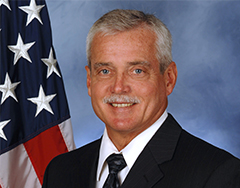
Dr. Jeffrey Sanders
2021 Pacific Operational Science & Technology (POST) Conference
Dr. Jeffrey H. Sanders, Civilian Senior Executive – Highly Qualified Expert, is the Chief Scientist of the Pacific Air Forces (PACAF), Joint Base Pearl-Harbor Hickam, Hawaii. As Chief Scientist he aids the rapid transition of new science and technology to support PACAF objectives. PACAF's mission is to deliver rapid and precise air, space, and cyberspace capabilities to protect and defend the U.S., its territories, and interests; to provide integrated air and missile defense; to promote interoperability throughout the 36 nations in PACAF's area of responsibility; to maintain strategic access and freedom of movement across all domains; and to respond across the full spectrum of military contingencies in order to restore Asia-Pacific security.
From 2015 to 2018, Dr. Sanders was the Air Force Research Laboratory’s Strategic Advisor to the Chief Scientist of the PACAF. Dr. Sanders provided HQ PACAF and the United States Indo-Pacific Command (INDOPACOM) with advice on Science and Technology (S&T) opportunities from AFRL and facilitated communication between the respective organizations. As Strategic Advisor he provided insight to AFRL about activities occurring at PACAF and INDOPACOM. He provided assistance for PACAF and INDOPACOM’s strategic planning processes and products, ensuring capability planning was captured in S&T investment planning, and providing input to key AF and OSD documents for critical support and reference. Being resident at HQ PACAF enabled timely notification of S&T challenges and opportunities to all AFRL Technology Directorates to ensure informed program planning.
From 2010 to 2015, Dr. Sanders served as Branch Chief for the Radio Frequency Exploitation Branch of the Layered Sensing Exploitation Division, Sensors Directorate, Air Force Research Laboratory, Wright-Patterson Air Force Base, Ohio. He led advanced technology activities in novel automatic target recognition concepts, simultaneous synthetic aperture radar product formation, and innovative multi-static radar exploitation algorithm development. He worked collaboratively with other Sensor Directorate divisions, Navy, and DARPA colleagues to focus research for contested environments. AFLCMC programs have been established to transition SAR exploitation R&D. Quick reaction support activities led to the fielding of ISR capabilities and deployment branch personnel in Afghanistan.
From 1996 to 2010, Dr. Sanders held a number of positions within the Materials and Manufacturing Directorate, Air Force Research Laboratory, Wright-Patterson Air Force Base, Ohio. These positions included research scientist, branch chief and division chief engineer. He advanced the state of the art in thin solid film coatings for use in high speed bearings for both air and space applications. He led research to investigate degradation methods of advanced high temperature liquid lubricants under consideration for next generation aircraft engines. His work involved close collaboration with AFOSR, NRO as well as other AFRL Directorates. He was assigned as acting Division Chief for approximately one year, and was assigned to AFMC HQ for a two year duty serving as the technical representative to an AF process improvement activity.
From 1990 to 1996, Dr. Sanders worked at NASA Marshall Space Flight Center in Huntsville, Alabama. He performed independent research using surface analytical techniques to support metallic alloy development activities for advanced turbo pump, main combustion chamber, and super lightweight tank materials. He provided expertise and analysis for Space Shuttle and payload issues.
Speakers
- Dr. Mohd Yazid Ahmad
- Kristen Baldwin, SES
- Col Corey Beaverson, USAF
- Gen Hawk Carlisle
- Dr. Jermont Chen
- Dr. Brad Dickey
- Terence Emmert
- Dr. Joe Evans
- Kim Fowler
- Adam Frost
- John Garnaut
- Huban Aspie Gowadia
- Dr. Steve Guillouzic
- Dr. Peter Highnam
- Gen Charles Holland, USAF (Ret)
- COL Victor Huang, RSN
- Dr. Dana Johnson
- Joan Johnson, SES
- Dr. George Ka'iliwai III, SES
- Joel Lane
- Dr. Martin Lindsey
- Dr. Paul Lopata
- Alexander Lovett
- Merry Lutz
- Katy Magnum
- Dr. Lindsay Millard
- Michael Monteleone III, SES
- CAPT Tony Nelipovich, USN
- Dr. Philip Perconti, SES
- Brig Gen Heather Pringle, USAF
- Col Marcia Quigley, USAF
- Dr. Daniel "Rags" Ragsdale
- Kevin Ruddell
- Dr. Jeffrey Sanders
- Dr. David Sandison
- Dr. John Sarrao
- RADM Lorin Selby, USN
- Dr. Derek Tournear
- Dr. James Trebes
- Michael Vaccaro
- Dr. Mike von Fahnestock
